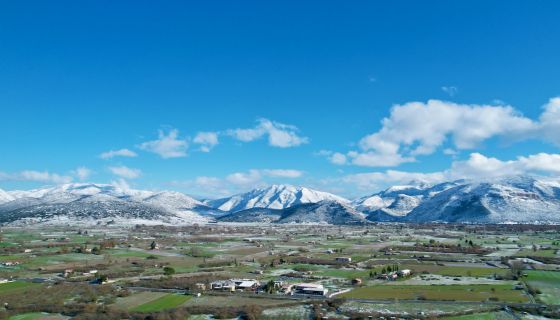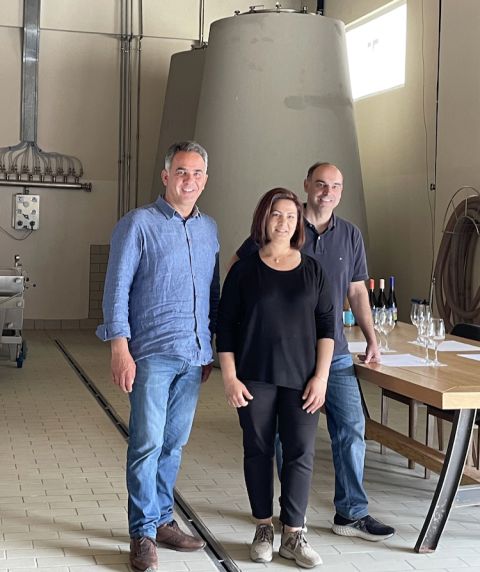From €15.20, $17.99, £18.75
Arcadia, defined in the Oxford English Dictionary as ‘A mountainous district in the Peloponnese of southern Greece’ and ‘a pastoral paradise’ in poetic fantasy, seems to be a fitting place of origin for this particularly unusual and delicious example of central Greece’s Moschofilero grape variety, which goes by various names depending on the skin colour. As explained in Wine Grapes, ‘These include Asprofilero (white), Xanthofilero (yellow-skinned), Mavrofilero (dark-skinned) and Fileri Kokkino (red-skinned).’ The white and yellow clones are relatively rare; the majority of vines in the region have pink or grey skins, similar to those of Pinot Gris, and are known as Moschofilero. (More on Moschofilero clones below.*)
For some reason, possibly fashion, most producers try their hardest not to let their wines be tinted by the colour in the skins, preferring to make a very white wine. This was the style of the first Moschofilero I tasted in the late 1990s, one that was relatively simple yet enchanting and distinctive. It made me want to discover more about Greek wines, especially the whites.
Troupis, on the other hand, have gone all out in the opposite direction, fermenting the juice with the skins and then keeping the wine with the skins for 100 days (ekato means ‘one hundred’) to produce a very deeply coloured rosé Moschofilero.
Here’s my captivated tasting note:
‘Gorgeously perfumed: tart red fruits, wild strawberries, roses, even jasmine. Equally deliciously scented on the palate with all those vibrant fruit flavours but less floral than the aroma. Less tannic than I expected after 100 days on the skins. Subtle as they are, the tannins are sufficient to give a counterpoint to this intense and fresh scent – a framework for the fragrance and producing some friction on the aftertaste. Extremely pure and clean, with low total sulphites (49 mg/l). Long and reverberant. Outrageously drinkable and full of shameless delight.’
The fruit for this wine comes mainly from the Troupis Litharakia vineyard, pictured above, which they have owned since the 1980s. The vines are 35–40 years old, planted in sandy clay loam with good drainage at an elevation of 650 m/2,133 ft). Troupis own a total of 24 ha (59 acres) of vineyards on the high, cool Mantinia plateau in the Peloponnese (located on this map), where grapes need the best sites to ripen fully, wines have plenty of refreshing acidity and alcohol levels remain relatively low – Ekato is 12.5% but 11.5% is not unusual for dry Moschofilero.
The vineyards are conventionally farmed but, as Thodoris Koutsoumpos, youngest generation of the Troupis family, explained, ‘we try to prevent the diseases, not to cure them. We try to be sustainable as much as we can, meaning that the first and the last sprays always consist of organic products, and having spontaneous cover crop all year long to avoid water evaporation and soil compaction.’
The grapes are hand-picked, then cooled for a day in big refrigerators near the winery to 4 °C (39 °F). This stops any unwanted microbial activity without having to add SO2 at this stage. The grapes are sorted very carefully because the berries have to be in perfect condition for a white wine fermented with the skins. They are then destemmed and fermented with ambient yeasts in a combination of concrete tanks (30%) and stainless-steel vats. The wine is bottled unfined and unfiltered with a relatively low level of SO2 added pre bottling.
I asked Koutsoumpos if this was a difficult style of Moschofilero to make. He replied. ‘We are not in Bordeaux, we are not stuck with tradition. We need to innovate and take risks to make wines such as this.’ He highlighted the risks involved in a fermentation that starts late – because of the cool ambient temperature in Mantinia and the reliance on ambient yeasts – and one that goes slowly. Other microbes are always keen to interfere …
The Troupis family have been involved in viticulture since the 1970s but did not start producing wine commercially until 2010, when the winery was built. The company is now run by founder Tasos Troupis’s daughter Pitsa Troupis (in charge of marketing and administration), her brother Yiannis Troupis (agronomist and vineyard manager) and Pitsa’s husband Kostas Koutsoumpos (winemaker and production manager).
The next generation is represented by 26-year-old Thodoris Koutsoumpos (below), whom I met in Athens at the launch of The Oxford Companion to Wine. His CV is as impressive as his emails since then have been concise and charming: he studied oenology and viticulture at the University of Athens, then an MSc in viticulture and oenology in Montpellier and a second MSc in mountain viticulture in Bolzano. During his studies he did internships at Château Angélus in St-Émilion, Pierre Paillard in Champagne, Pfeiffer Wines in Rutherglen, Australia, and will be at Viña Koyle in Chile’s Colchagua Valley later this year. That hasn’t stopped him from working alongside Troupis’s oenologist Demetris Akrivos at harvest time every year. From 2024 he will be full-time back in Mantinia.
The Ekato is not the only striking Moschofilero they make. Their Hoof & Lur, one of this year’s 50 Great Greek Wines, is another. (They had a second wine in that top 50, their delicious Pitys Ritinitis, a retsina made with the Assyrtiko they’ve planted.) They have also planted an experimental plot of Koliniatiko, a rare, dark-skinned local variety. They make just 5,500–6,000 bottles of the Ekato annually.
The wine is imported into the UK by Bancroft Wines and is available directly from their website at £23.50. It is also available from the retailers listed via the Wine-Searcher link at the top of the page. The US importer is DNS imports. To find out more about stockists in the US, email dionysi@dnswines.com.
*Together with Greece’s top vine nursery, run by Kostas Baskietas, Troupis have experimented with a range of different Moschofilero clones and rootstocks that are not traditional in the region, and for his MSc thesis Thodoris studied the effect of irrigation and rootstocks on growth performance and berry quality of Moschofilero. They have also planted a clone that they think will be particularly well-suited to making sparkling wine, which is their next project.
For more notes on wines made from this variety, see our tasting notes database. All the photos are courtesy of the producer.



















